+ Open data
Open data
- Basic information
Basic information
| Entry | Database: PDB / ID: 4j6g | |||||||||
|---|---|---|---|---|---|---|---|---|---|---|
| Title | CRYSTAL STRUCTURE OF LIGHT AND DcR3 COMPLEX | |||||||||
 Components Components | (Tumor necrosis factor ... ) x 2 ) x 2 | |||||||||
 Keywords Keywords |  IMMUNE SYSTEM / IMMUNE SYSTEM /  LIGHT / LIGHT /  DCR3 / TNF / DCR3 / TNF /  TNFR / TNF14 / TNFR / TNF14 /  STRUCTURAL GENOMICS / PSI-BIOLOGY / NEW HVEM / STRUCTURAL GENOMICS / PSI-BIOLOGY / NEW HVEM /  N-GLYCOSYLATION / N-GLYCOSYLATION /  MEMBRANE / MEMBRANE /  SECRETED PROTEIN / SECRETED PROTEIN /  CYTOKINE / IFN / CYTOKINE / IFN /  JELLY-ROLL FOLD / BIND TNF RECEPTOR HVEM AND LTBR / LTBR / JELLY-ROLL FOLD / BIND TNF RECEPTOR HVEM AND LTBR / LTBR /  Protein Structure Initiative / Atoms-to-Animals: The Immune Function Network / New York Structural Genomics Research Consortium / NYSGRC Protein Structure Initiative / Atoms-to-Animals: The Immune Function Network / New York Structural Genomics Research Consortium / NYSGRC | |||||||||
| Function / homology |  Function and homology information Function and homology informationTNFs bind their physiological receptors / TNF receptor superfamily (TNFSF) members mediating non-canonical NF-kB pathway / positive regulation of T cell chemotaxis / T cell chemotaxis /  tumor necrosis factor receptor binding / positive regulation of myoblast fusion / T cell homeostasis / cysteine-type endopeptidase inhibitor activity involved in apoptotic process / positive regulation of myoblast differentiation / T cell proliferation ...TNFs bind their physiological receptors / TNF receptor superfamily (TNFSF) members mediating non-canonical NF-kB pathway / positive regulation of T cell chemotaxis / T cell chemotaxis / tumor necrosis factor receptor binding / positive regulation of myoblast fusion / T cell homeostasis / cysteine-type endopeptidase inhibitor activity involved in apoptotic process / positive regulation of myoblast differentiation / T cell proliferation ...TNFs bind their physiological receptors / TNF receptor superfamily (TNFSF) members mediating non-canonical NF-kB pathway / positive regulation of T cell chemotaxis / T cell chemotaxis /  tumor necrosis factor receptor binding / positive regulation of myoblast fusion / T cell homeostasis / cysteine-type endopeptidase inhibitor activity involved in apoptotic process / positive regulation of myoblast differentiation / T cell proliferation / T cell costimulation / tumor necrosis factor receptor binding / positive regulation of myoblast fusion / T cell homeostasis / cysteine-type endopeptidase inhibitor activity involved in apoptotic process / positive regulation of myoblast differentiation / T cell proliferation / T cell costimulation /  T cell activation / T cell activation /  cytokine activity / TNFR2 non-canonical NF-kB pathway / positive regulation of non-canonical NF-kappaB signal transduction / cellular response to mechanical stimulus / cytokine activity / TNFR2 non-canonical NF-kB pathway / positive regulation of non-canonical NF-kappaB signal transduction / cellular response to mechanical stimulus /  signaling receptor activity / signaling receptor activity /  immune response / immune response /  signaling receptor binding / apoptotic process / negative regulation of apoptotic process / signaling receptor binding / apoptotic process / negative regulation of apoptotic process /  signal transduction / signal transduction /  extracellular space / extracellular region / identical protein binding / extracellular space / extracellular region / identical protein binding /  plasma membrane / plasma membrane /  cytoplasm cytoplasmSimilarity search - Function | |||||||||
| Biological species |   Homo sapiens (human) Homo sapiens (human) | |||||||||
| Method |  X-RAY DIFFRACTION / X-RAY DIFFRACTION /  SYNCHROTRON / SYNCHROTRON /  MOLECULAR REPLACEMENT / Resolution: 2.4 Å MOLECULAR REPLACEMENT / Resolution: 2.4 Å | |||||||||
 Authors Authors | Liu, W. / Zhan, C. / Bonanno, J.B. / Bhosle, R.C. / Nathenson, S.G. / Almo, S.C. / Atoms-to-Animals: The Immune Function Network (IFN) / New York Structural Genomics Research Consortium (NYSGRC) | |||||||||
 Citation Citation |  Journal: Structure / Year: 2014 Journal: Structure / Year: 2014Title: Mechanistic basis for functional promiscuity in the TNF and TNF receptor superfamilies: structure of the LIGHT:DcR3 assembly. Authors: Liu, W. / Zhan, C. / Cheng, H. / Kumar, P.R. / Bonanno, J.B. / Nathenson, S.G. / Almo, S.C. | |||||||||
| History |
|
- Structure visualization
Structure visualization
| Structure viewer | Molecule:  Molmil Molmil Jmol/JSmol Jmol/JSmol |
|---|
- Downloads & links
Downloads & links
- Download
Download
| PDBx/mmCIF format |  4j6g.cif.gz 4j6g.cif.gz | 134.9 KB | Display |  PDBx/mmCIF format PDBx/mmCIF format |
|---|---|---|---|---|
| PDB format |  pdb4j6g.ent.gz pdb4j6g.ent.gz | 103.1 KB | Display |  PDB format PDB format |
| PDBx/mmJSON format |  4j6g.json.gz 4j6g.json.gz | Tree view |  PDBx/mmJSON format PDBx/mmJSON format | |
| Others |  Other downloads Other downloads |
-Validation report
| Arichive directory |  https://data.pdbj.org/pub/pdb/validation_reports/j6/4j6g https://data.pdbj.org/pub/pdb/validation_reports/j6/4j6g ftp://data.pdbj.org/pub/pdb/validation_reports/j6/4j6g ftp://data.pdbj.org/pub/pdb/validation_reports/j6/4j6g | HTTPS FTP |
|---|
-Related structure data
| Related structure data | 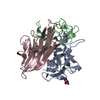 4en0SC 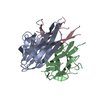 4kg8C 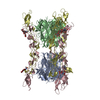 4kggC 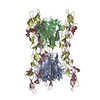 4kgqC S: Starting model for refinement C: citing same article ( |
|---|---|
| Similar structure data | |
| Other databases |
- Links
Links
- Assembly
Assembly
| Deposited unit | 
| ||||||||
|---|---|---|---|---|---|---|---|---|---|
| 1 | 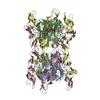
| ||||||||
| 2 | 
| ||||||||
| 3 | 
| ||||||||
| Unit cell |
|
- Components
Components
-Tumor necrosis factor ... , 2 types, 4 molecules ABCD
| #1: Protein | Mass: 18188.549 Da / Num. of mol.: 2 / Fragment: UNP residues 83-240 / Mutation: K214E Source method: isolated from a genetically manipulated source Source: (gene. exp.)   Homo sapiens (human) / Gene: TNFSF14, HVEML, LIGHT, UNQ391/PRO726 / Production host: Homo sapiens (human) / Gene: TNFSF14, HVEML, LIGHT, UNQ391/PRO726 / Production host:   Drosophila (fruit flies) / References: UniProt: O43557 Drosophila (fruit flies) / References: UniProt: O43557#2: Protein | Mass: 19044.217 Da / Num. of mol.: 2 / Fragment: UNP residues 30-195 Source method: isolated from a genetically manipulated source Source: (gene. exp.)   Homo sapiens (human) / Gene: TNFRSF6B, DCR3, TR6, UNQ186/PRO212 / Production host: Homo sapiens (human) / Gene: TNFRSF6B, DCR3, TR6, UNQ186/PRO212 / Production host:   Drosophila (fruit flies) / References: UniProt: O95407 Drosophila (fruit flies) / References: UniProt: O95407 |
|---|
-Sugars , 2 types, 2 molecules 
| #3: Polysaccharide | alpha-D-mannopyranose-(1-3)-beta-D-mannopyranose-(1-4)-2-acetamido-2-deoxy-beta-D-glucopyranose-(1- ...alpha-D-mannopyranose-(1-3)-beta-D-mannopyranose-(1-4)-2-acetamido-2-deoxy-beta-D-glucopyranose-(1-4)-2-acetamido-2-deoxy-beta-D-glucopyranose / Mass: 748.682 Da / Num. of mol.: 1 / Mass: 748.682 Da / Num. of mol.: 1Source method: isolated from a genetically manipulated source |
|---|---|
| #6: Sugar | ChemComp-NAG /  N-Acetylglucosamine N-Acetylglucosamine |
-Non-polymers , 3 types, 50 molecules 




| #4: Chemical |  Chloride Chloride#5: Chemical | #7: Water | ChemComp-HOH / |  Water Water |
|---|
-Experimental details
-Experiment
| Experiment | Method:  X-RAY DIFFRACTION / Number of used crystals: 1 X-RAY DIFFRACTION / Number of used crystals: 1 |
|---|
- Sample preparation
Sample preparation
| Crystal | Density Matthews: 3.71 Å3/Da / Density % sol: 66.81 % |
|---|---|
Crystal grow | Temperature: 290 K / Method: vapor diffusion, sitting drop / pH: 5.5 Details: 0.2M SODIUM CHLORIDE, 0.1M SODIUM CITRATE:CITRIC ACID BUFFER 1.0M AMMONIUM PHOSPHATE DIBASIC, PH5.5,, VAPOR DIFFUSION, SITTING DROP, temperature 290K |
-Data collection
| Diffraction | Mean temperature: 100 K |
|---|---|
| Diffraction source | Source:  SYNCHROTRON / Site: SYNCHROTRON / Site:  NSLS NSLS  / Beamline: X29A / Wavelength: 1.075 / Beamline: X29A / Wavelength: 1.075 |
| Detector | Type: ADSC QUANTUM 315 / Detector: CCD / Date: Aug 2, 2012 |
| Radiation | Protocol: SINGLE WAVELENGTH / Monochromatic (M) / Laue (L): M / Scattering type: x-ray |
| Radiation wavelength | Wavelength : 1.075 Å / Relative weight: 1 : 1.075 Å / Relative weight: 1 |
| Reflection | Resolution: 2.4→50 Å / Num. obs: 43288 / % possible obs: 100 % / Redundancy: 11.2 % / Rmerge(I) obs: 0.102 / Rsym value: 0.077 / Net I/σ(I): 27.2 |
| Reflection shell | Resolution: 2.4→2.44 Å / Redundancy: 11.2 % / Rmerge(I) obs: 0.81 / Mean I/σ(I) obs: 3.5 / Rsym value: 0.774 / % possible all: 100 |
- Processing
Processing
| Software |
| ||||||||||||||||||||||||||||||||||||||||||||||||||||||||||||||||||||||||||||||||||||||||||||||||||||||||||||||||||||||||||||||||||||||||||||||||||||||||||||||||||||||||||
|---|---|---|---|---|---|---|---|---|---|---|---|---|---|---|---|---|---|---|---|---|---|---|---|---|---|---|---|---|---|---|---|---|---|---|---|---|---|---|---|---|---|---|---|---|---|---|---|---|---|---|---|---|---|---|---|---|---|---|---|---|---|---|---|---|---|---|---|---|---|---|---|---|---|---|---|---|---|---|---|---|---|---|---|---|---|---|---|---|---|---|---|---|---|---|---|---|---|---|---|---|---|---|---|---|---|---|---|---|---|---|---|---|---|---|---|---|---|---|---|---|---|---|---|---|---|---|---|---|---|---|---|---|---|---|---|---|---|---|---|---|---|---|---|---|---|---|---|---|---|---|---|---|---|---|---|---|---|---|---|---|---|---|---|---|---|---|---|---|---|---|---|
| Refinement | Method to determine structure : :  MOLECULAR REPLACEMENT MOLECULAR REPLACEMENTStarting model: PDB ENTRY 4EN0 Resolution: 2.4→19.93 Å / Cor.coef. Fo:Fc: 0.947 / Cor.coef. Fo:Fc free: 0.922 / SU B: 5.459 / SU ML: 0.128 / Cross valid method: THROUGHOUT / ESU R: 0.22 / ESU R Free: 0.193 / Stereochemistry target values: MAXIMUM LIKELIHOOD / Details: HYDROGENS HAVE BEEN ADDED IN THE RIDING POSITIONS
| ||||||||||||||||||||||||||||||||||||||||||||||||||||||||||||||||||||||||||||||||||||||||||||||||||||||||||||||||||||||||||||||||||||||||||||||||||||||||||||||||||||||||||
| Solvent computation | Ion probe radii: 0.8 Å / Shrinkage radii: 0.8 Å / VDW probe radii: 1.2 Å / Solvent model: MASK | ||||||||||||||||||||||||||||||||||||||||||||||||||||||||||||||||||||||||||||||||||||||||||||||||||||||||||||||||||||||||||||||||||||||||||||||||||||||||||||||||||||||||||
| Displacement parameters | Biso mean: 41.906 Å2
| ||||||||||||||||||||||||||||||||||||||||||||||||||||||||||||||||||||||||||||||||||||||||||||||||||||||||||||||||||||||||||||||||||||||||||||||||||||||||||||||||||||||||||
| Refinement step | Cycle: LAST / Resolution: 2.4→19.93 Å
| ||||||||||||||||||||||||||||||||||||||||||||||||||||||||||||||||||||||||||||||||||||||||||||||||||||||||||||||||||||||||||||||||||||||||||||||||||||||||||||||||||||||||||
| Refine LS restraints |
| ||||||||||||||||||||||||||||||||||||||||||||||||||||||||||||||||||||||||||||||||||||||||||||||||||||||||||||||||||||||||||||||||||||||||||||||||||||||||||||||||||||||||||
| LS refinement shell | Resolution: 2.402→2.464 Å / Total num. of bins used: 20
|
 Movie
Movie Controller
Controller



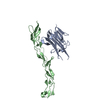


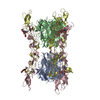
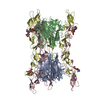
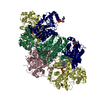

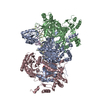

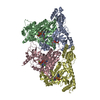

 PDBj
PDBj



